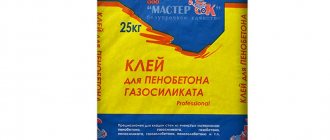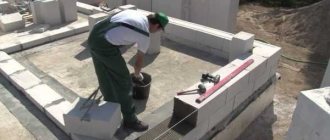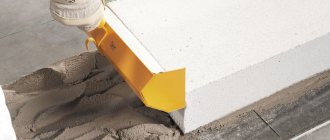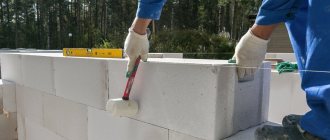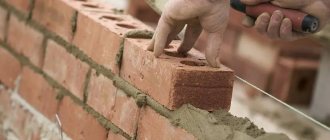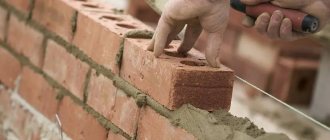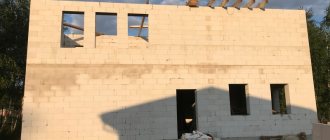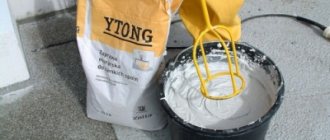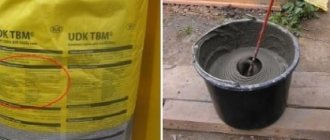When using foam blocks as a material for constructing walls, they must be fastened together with compounds that are similar in density to foam concrete. The adhesive intended for foam concrete blocks can be used quite economically; It will take a little time for it to set. The composition can provide walls with almost monolithic integrity. The soundproofing and heat-saving properties of the walls of a building and its strength largely depend on the quality of such a solution.
The soundproofing and heat-saving properties of the building walls and its strength depend on the quality of the glue for foam blocks.
Glue consumption for foam blocks per 1m2/m3
The glue consumption rate per 1 m2 is approximately 1.5–1.6 kg of dry powder with an applied thickness of 1 mm, therefore, 15–30 kg will be consumed per 1 m³. As we can see, the numbers are approximate, since it is almost impossible to give an exact figure for how much glue is needed per foam block cube. But we will allow ourselves to average the indicators - and name a certain weight - 25 kg. This is exactly the weight of one bag of adhesive composition. Knowing this, it will be easy for moms to calculate how much glue is needed to build the masonry. And for greater convenience, we present to your attention the list below:
- per 1 m² - ≈1.5 kg;
- per 1 m³ - ≈25 kg (one bag).
This is the glue consumption for foam blocks 20x30x60/40x30x60 - the average is 25 kg. But in practice, things can happen completely differently. It also happens that ≈1.5 bags are consumed per 1 m³. The fact is that this is influenced by certain factors, which we will now list in the form of a list:
- use of the tool. Here improvisation will be inappropriate - the tools we need to use are those that are intended for our purposes;
- condition of masonry materials. Their surface should be even and smooth, but it happens that their condition cannot be called ideal;
- weather. During the cold season, it is better to refrain from such work, especially if you are not a professional in this matter;
- master's qualification. This point follows from the previous one. Naturally, to perform such work properly, certain knowledge and experience in this field is required.
The method of applying and preparing the adhesive composition also affects its consumption. Therefore, when preparing, you need to use only a drill mixer (kneading by hand is a thankless task), and dilute with water until a homogeneous consistency. The composition should not be very dry and thick, but also not too thin and liquid, since - in both cases - it will not perform the functions assigned to it.
I have heard the opinion that the composition can be diluted with sand in proportions of almost 1:1. Allegedly, this will increase strength and, most importantly, it’s cheaper, because less dry powder will be used.
So, this opinion is wrong. Mixing sand (or anything else) is not allowed. Otherwise, the composition will be heterogeneous, the layer will be uneven and, as a result, the wall will be uneven. And this should not be allowed, even if you are pursuing such noble goals as saving or increasing strength. In addition, there will be no savings here. To even out the layer, you will have to make it thicker, because, as they say, that’s what it will do.
The composition should be applied to the surface of the block in an even, thin layer. The thickness is usually up to 3 mm. Naturally, no one specifically measures this indicator unless it is laboratory research. In this matter, as in any other, you need skill, which comes with practice. But this matter cannot be called overly complicated. Having laid 5-10 elements of the future structure, you will already be laying them as if you have been doing this all your life.
Keep in mind that no matter how accurate your calculations may seem to you, the material must be purchased with a small margin. This applies not only to the glue, but also to the masonry elements themselves. If you have small leftovers, this is not critical. In any case, they may be needed another time, but if suddenly something is missing, it is much worse, especially if you need to complete construction in a limited time.
So we figured out how much glue is needed for one cube of foam block. We can draw an analogy with both aerated concrete and gas silicate. After all, all the listed building materials belong to the same group and they are laid according to the same principle.
What are the costs of connecting adhesive mixtures
To ensure a strong connection of foam blocks, professional craftsmen recommend making an adhesive layer 3-8 millimeters thick.
The material consumption will be different everywhere, since it all depends on the level of skill of the specialist and the quality of the glue (don’t skimp on it).
And if you are going to live in cold regions, then to increase thermal insulation during construction, it is advisable to double lay foam blocks (this will consume even more material).
In addition, the level of consumption can be affected by the device used to apply the glue (using a spatula with teeth will significantly reduce costs), as well as the weather (the glue can deteriorate in cold weather).
Glue consumption per 1 m3: online calculator
How to correctly calculate the cement consumption per 1 cubic meter of mortar: for screed, masonry, plaster, foundation.
The average glue consumption for aerated concrete blocks per 1 m3 is 14–17 kg. with a seam thickness of 2–8 mm. This indicator may vary depending on the conditions of use of the installation material:
- Different manufacturers use different volumes and types of components to produce dry mixes. Therefore, consumption may vary depending on the brand of material.
- Air and base temperature. The lower the temperature, the more mixture will be required.
- If there is a reinforcing gasket, the consumption will be higher.
- The integrity of block elements also affects the amount of building mixture. If there are chips, they will have to be built up using adhesive material to achieve an even plane.
You can also use an online calculator to calculate the required number of aerated concrete blocks and glue.
Glue consumption: 25 kg per 1 m3 of aerated concrete blocks with an adhesive layer thickness of no more than 3 mm and block size 600x375x250.
The online calculator for aerated concrete blocks is designed to perform calculations of the building materials needed for the construction of walls of houses, garages, utility and other premises. The calculations can take into account the dimensions of the building's gables, door and window openings, as well as related materials, such as mortar and masonry mesh.
Be careful when filling out the data, pay special attention to the units of measurement
When filling out the data, pay attention to the additional information with the Additional information sign
The production of aerated concrete in a factory is a rather complex process. In addition to cement and sand, chemical gas-forming additives are used in production, the amount of which must be calculated with very high accuracy. After all the components are mixed, the whole mass of aerated concrete is poured into special forms, in which it increases in volume due to the release of gases.
The main feature of the production of cellular concrete is the hardening of poured concrete under pressure in special autoclave chambers. This is necessary so that the air pores are distributed evenly throughout the entire volume. The production of high-quality aerated concrete without such chambers is impossible. After gaining the required strength, the entire array is cut into blocks of the required sizes.
Before purchasing aerated concrete blocks, you need to calculate their quantity as accurately as possible using a calculator so that you do not have to overpay for excess material.
Just like other types of blocks, aerated concrete blocks are divided according to density into:
- structural
– for the construction of load-bearing walls
structural and thermal insulation
– for the construction of load-bearing walls of low-rise buildings
thermal insulation
– for the construction of self-supporting walls
Due to their characteristics, such as light weight, good thermal insulation, ease of machining, aerated concrete blocks are a very popular building material, and continue to rapidly gain popularity. But do not forget that good thermal insulation of this material is achieved only if all the rules of construction from aerated concrete blocks are observed, such as masonry with special masonry adhesive, additional protection from precipitation, good waterproofing and vapor barrier, as well as correct calculation of the required wall thickness, in depending on the weather conditions of each specific region.
The disadvantages of this material include:
- High fragility
- The need to use special devices for attaching hanging objects to walls
- High water absorption, resulting in an increase in the declared thermal conductivity
- Strong dependence of thermal insulation characteristics on the strength of the blocks
- Using relative characteristics for advertising purposes
When choosing materials for building a house, be sure to consult with independent specialists in your region. Don't believe loud advertising claims.
Adhesive mixtures and their advantages
Aerated concrete adhesive has several advantages over conventional sand mixtures. When using it, the humidity of aerated concrete blocks does not increase. Hardening occurs without shrinkage, and the adhesive mixture can be used as a putty.
For this reason, you need to be careful when working and maintain the required speed.
In addition, adhesive for gas concrete has several other advantages:
- due to a more complex composition and polymer-based additives, masonry can be done at sub-zero temperatures;
- no complex preliminary work is required when preparing the mixture;
- constant composition of the glue, which gives the same adhesion properties and the possibility of using thinner seams;
- the solution consumption is four times lower than the sand mixture;
- Thanks to the possibility of using thinner seams, the overall level of heat loss is reduced.
Components
In terms of their composition and the presence of various components, adhesives for aerated concrete are quite diverse. There are also special brands that have various additives that allow them to work at low temperatures. All mixtures for gas silicate blocks are based on the following components:
- fine sand;
- high quality cement;
- modifiers that prevent cracking due to temperature changes;
- polymer-based additives that reduce thermal conductivity and allow the adhesive composition not to freeze at temperatures down to minus 10 degrees.
Frost-resistant adhesive used for masonry in winter contains additional components that increase resistance to low temperatures.
Selection options
There is a wide selection of adhesive compositions on the market designed for laying aerated concrete blocks. When choosing a particular brand, first of all, it is worth considering the conditions under which the masonry will be carried out.
Obviously, for work at low temperatures, frost-resistant mixtures should be purchased. The temperature range for which the adhesive composition is designed is indicated on the packaging
Let's not forget that most mixtures begin to set within 10 minutes, and complete hardening occurs within 2 hours. Depending on the brand, these parameters may vary, but these are the average indicators. If you do not have good skills in laying gas blocks, then it is better to purchase glue with a longer hardening time.
Glue consumption per 1 m3
The consumption of mortar for laying one cubic meter of cellular blocks depends on several indicators. To make a more accurate calculation, you can use a special calculator, which is available on many construction websites. Also, the consumption per 1 m3 is calculated according to the formula: S = [(L + H)/L x H] x B x 1.4, where:
| Variable name | Variable value |
| S | total mixture consumption |
| L | block length |
| H | block height |
| B | seam thickness |
| 1.4 | dry glue consumption coefficient per 1 m2 with a 1 mm seam |
Also, the mortar for laying aerated concrete can be consumed more or less depending on the following factors:
- block surface quality;
- climatic conditions under which masonry is carried out;
- tools used during work;
- presence of reinforcement.
To a large extent, the consumption of the solution is also influenced by the level of training of the worker.
Calculation of gas silicate for the house with your own hands
Do-it-yourself aerated concrete house: step-by-step independent construction of a house
Self-calculation takes a significant amount of time and requires basic skills in working with a calculator. Knowing the volume of the wall and one block, we will try to calculate the required quantity.
Let's imagine that we are building a rectangular house with a wall length of 12 and 15 m. The ceiling height is 2.5 m. We use the most popular block of the 600x300x200 format.
- let's find the volume of the walls, knowing its area and the thickness of the block: length of the walls, 12 m x 2 + 15 m x 2 = 54 m;
- area, 54 m x 2.5 m = 135 m2;
- volume, 135 m2 x 0.6 m = 81 m3;
- the volume of the block is easier to calculate: 0.6 m x 0.3 m x 0.2 m = 0.036 m3;
- divide the volume of the walls by the volume of one block and get the quantity:
- 81 m3 / 0.036 m3 = 2250 blocks.
Happy calculations and easy construction!
Differences between glue and cement mortar - why is it better?
Where is cement m200 (m 200) used: technical characteristics, composition, material consumption
The technology for properly laying foam concrete differs from the methods of installing other wall materials, and cement mortar is not suitable for its implementation. The thermal insulation properties of foam concrete blocks are higher than those of mortar, and thick layers of the latter make the structure drafty and cold. When using this installation method, you will have to install additional thermal insulation from the inside or outside of the wall.
The problem is solved by using a special adhesive composition. It forms a thin seam - durable, airtight and waterproof, so the room will be noticeably warmer. In addition, laying blocks with glue is easier, faster, and it hardens sooner, reducing construction time. Cement mortar contains a lot of water, which immediately begins to be absorbed into the porous structure of the blocks, so you will also have to spend money on a water-repellent primer.
There are cases when it is still possible to lay blocks on a regular solution:
- material size – about 30 cm;
- incorrect product geometry;
- deviations in height – more than 1.5 cm;
- presence of chips.
Block sizes and masonry sizes
Most of the foam blocks sold on the market are produced using GOST 21520-89. The most popular are foam blocks with dimensions in mm:
- 200 x 300 x 600; 200 x 200 x 600; 100-, 200-, 300- and 400 x 600 x 250 mm; 600 x 300, 588 x 288, 500 x 300, 400 x 200, the third size for all is 200 mm.
Polystyrene concrete blocks are also used - a mixture of cement, quartz sand and granulated polystyrene foam. Their dimensions are also specified according to GOST 21520-89, in mm:
- length from 598 to 288; height from 298 to 88; thickness from 300 to 195.
The most popular are polystyrene foam blocks with dimensions, in mm:
- wall - 588x300x188 and 588x380x300; partition - 588x600x92; lintels - 380x300x1300.
Adhesive for foam blocks: varieties, temperature of use and consumption
Each building material has specific features, taking into account which they are used in certain works on the construction of buildings and structures. In addition, taking into account the existing characteristics, a composition is selected for each product that can provide reliable fixation. Among the available range of materials, it is worth highlighting foam blocks, which also require a high-quality adhesive composition.
Advantages and disadvantages
When choosing an easy-to-install and high-quality building material for the construction of walls, experts are increasingly giving preference to foam concrete blocks. However, the positive features of the products can be appreciated only when they are laid not on ordinary cement mortar, but when using special glue. This composition is distinguished by its viscosity, sets more effectively, and does not shrink after hardening; in addition, the blocks, which are distinguished by their porous structure, do not absorb moisture from it, due to which it is considered better than cement mortar. The products are in demand in the construction of new buildings, as well as in the reconstruction and modernization of old buildings. Both residential buildings and country houses, baths and saunas are erected from blocks. The material can be used not only for laying load-bearing walls, but also as a product for installing partitions, as well as raw materials for performing work to ensure thermal and sound insulation of buildings.
As for glue for foam blocks, it is necessary to highlight the following main advantages of its use:
- since the seam formed by the adhesive composition is thinner than the layer of cement mortar, the appearance of “cold bridges” between structural elements is practically eliminated;
- the consumption of the composition also depends on the small thickness of the layer, which will be less in comparison with other compositions;
- due to the need for less substance for work, the time for preparing the mixture can be significantly reduced, which also reduces labor costs;
- diluting the composition does not require the use of special devices for mixing the material; a conventional drill is suitable for preparatory work with glue;
- the specific properties of the product have a positive effect on the sound-proofing and heat-insulating properties of the building material;
- good plasticity of the mixture makes it possible to adjust the laying of blocks;
- the adhesive composition is moisture-resistant, so the likelihood of microorganisms forming on the base is excluded;
- due to the minimal thickness of the connecting seam, there is no need for additional processing of the base for leveling, which makes it possible to reduce costs associated with finishing work on walls and partitions;
- the mixture is sold in small bags, due to which the products can be transported in ordinary passenger vehicles without using trucks;
- All components of the glue are completely safe for humans and the environment.
In addition to positive qualities, such compositions have the following disadvantages:
- the products are highly expensive, due to which they are used mainly for the construction of small buildings, however, by adhering to the recommendations for dilution of the composition, it is possible to achieve rational use of the products, which will not significantly affect costs;
- It is not possible to visually determine the quality of the mixture.
To reduce the risk of purchasing goods that will have low quality characteristics, it is necessary to focus on the following nuances:
- to carry out installation work in winter at sub-zero temperatures, you should buy glue that contains special frost-resistant additives that affect the properties of the entire mixture;
- experts recommend not to rush to purchase recently released material; it is better to opt for a composition with a later date of manufacture;
- products from little-known brands should not be considered for work, since there is a risk that the product is of poor quality; products of popular and well-known brands rarely have low performance characteristics, with the exception of counterfeits of this brand;
- When calculating the required amount of mixture required for work, some errors should be taken into account, which in any case may arise during the laying of foam blocks, so it is better to have at least one extra bag of glue in stock.
Which adhesive for foam blocks is better
A wide selection of dry mixtures for connecting foam blocks leaves developers confused. How not to make mistakes when buying glue? What is the best place to put foam blocks on?
Remember simple rules:
- don’t go for the cheap;
- buy products from well-known manufacturers;
- Consider the time of year during which construction work will take place. For the winter, choose a frost-resistant composition;
- After calculating the required number of bags, take one in reserve.
For you - a review of popular brands of dry mixes and adhesive compositions for laying foam blocks. These compositions have earned positive reviews from professionals.
Volma
Adhesive for Volma foam blocks consists of fractionated sand, cement, high quality dispersion additives and fillers. Manufacturers recommend making a seam with a thickness of 2 to 5 mm.
Volma-block mounting adhesive is often used by builders when laying blocks and slabs of high-quality cellular concrete. The composition is suitable for leveling surfaces and laying walls. Release form: 25 kg bag.
Adhesive foam Titan
After its appearance on the market, many builders were skeptical about the new product from the Selena company. But, after the first experiments, doubts about the quality and effectiveness of the innovative product were dispelled.
Titanium mounting foam adhesive for foam blocks replaces cement-based solutions. It is enough to apply stripes of the new product to the foam blocks and simply glue them together. The finished structure is strong and reliable. Construction is progressing very quickly.
The volume of the cylinder is 750 ml. Price – 336 rubles.
Experts recommend observing several conditions when building a house from foam blocks using Titan assembly foam adhesive. Necessarily:
- Leave the work to professionals. Low qualifications of craftsmen will lead to disastrous results.
- Choose foam blocks with a perfectly flat surface.
- The foam layer should not exceed the recommended thickness.
- Cover the external joints between the blocks with cement: the foam is deformed under the influence of sunlight.
- Lay the first row of foam blocks only on cement mortar. Breaking the rule is unacceptable. Under load, Titanium mounting adhesive foam is deformed.
Knauf
Many builders recommend Knauf Perlfix foam block adhesive. High quality adhesion is ensured by the gypsum base and polymer additives.
Using Perlfix Knauf glue allows you to quickly level the walls without installing a frame. Another advantage is the environmental friendliness of the composition.
The standard adhesive consumption for Perlfix Knauf foam blocks is about 5 kg/sq. m. Release form – kraft bags of 30 kg.
IVSIL Block/IVSIL Block
High-quality adhesive for laying grooved and grooveless slabs. The cement-based dry mixture is suitable for foam and gas blocks, foam concrete. The filler is sand of fine fractions, the composition contains imported polymer additives that increase adhesion.
The thickness of the seam is from 2 mm; the position of the glued blocks can be adjusted within a quarter of an hour. With a layer thickness of 2 mm, the consumption will be from 2.5 to 3 kg per square meter. IVSIL Block dry mixture is packaged in 25 kg bags.
Tile adhesive
Builders who have been constructing structures made of foam blocks for many years are advised to carefully consider the choice of adhesive composition. If you haven’t found a special glue for foam blocks, take regular frost-resistant tile adhesive.
Tips from the pros:
- You can use glue only if the geometry of the blocks is correct (deviation of no more than 1.5 mm in height).
- Tile adhesive is suitable for laying foam blocks up to 100 mm in size.
- Only a highly qualified master can lay foam blocks with glue (including tiles).
How to make a sheathing for metal tiles? You will find out the answer to this question by reading this article.
And in this article you will read how to cover a roof with roofing felt.
Manufacturers
A wide range of adhesive compositions for laying foam blocks often confuses finishers. How to choose the right composition? How not to make a mistake when purchasing a mixture? What should foam blocks be mounted on?
To get started, remember a few simple rules:
the stingy pays twice - do not try to chase the cheapness, purchase a product from a well-known manufacturer that has a good reputation in the building mixtures market when making a purchasing decision, take into account the time of year and temperature conditions under which the work will be carried out - for the winter it is advisable to purchase a frost-resistant composition
And now let’s get acquainted with the creators of the most popular adhesive compositions, which have earned positive reviews from professionals around the world.
Volma
Volma is one of the leaders in the construction market, having won recognition from consumers in Russia and abroad. The adhesive of this brand consists of selected cement, fine-grained sand, filler and pigments of the most exceptional quality. This composition is used for seams of 2-5 mm.
Finishers use this glue when installing slabs from cellular concrete blocks.
Sold in paper bags of 25 kg.
Titanium
When adhesive foam from the famous Titan brand first appeared on the market, most professionals were skeptical about this new product. However, after the first applications, doubts about the quality and exceptional consumer performance of the composition completely disappeared.
Titan products replace cement mortars and are very easy to use - you just need to apply a strip of the composition to the blocks and fix them. Construction is progressing quite quickly, and the finished structure is durable and stable.
When using foam adhesive, you should adhere to several rules:
- the surface of the foam blocks should only be flat;
- the adhesive layer is applied in accordance with the instructions, do not exceed the thickness recommended by the manufacturer;
- the foam shrinks under the influence of direct ultraviolet rays, so the outside joints should be sealed with cement;
- Adhesive foam is used only for the second layer of foam blocks. The first must be applied to a cement-sand mortar, otherwise the glue will quickly deform under the heavy weight.
Sold in 750 ml cylinders.
Knauf
Knauf Perlfix adhesive provides a high level of adhesion thanks to a gypsum base and special polymer additives.
The use of glue does not require preliminary installation of the frame, the work is carried out quickly, and the structure is stable.
The undoubted advantage of the composition is its environmental safety, which is why it is widely used in private housing construction.
The glue is used quite economically - for processing a coating of 1 sq. m. only 5 kg of composition will be required.
Sold in kraft bags, packaged 30 kg.
IVSIL Block/IVSIL Block
The glue from this manufacturer is widely used when laying foam concrete and gas blocks. The mixture is a dry powder composition based on cement with a small content of additives that increase surface adhesion.
Used for seams from 2 mm, with this glue consumption will be within 3 kg per m2.
When using glue, you can adjust the position of the foam blocks within 15 minutes from the moment of fixation.
Sold in bags of 25 kg.
Founds Selform T112
This is a frost-resistant composition intended for use in winter. The formed seams can easily withstand up to 75 freezing and thawing cycles - this figure is one of the highest among winter types of adhesive for foam concrete.
The adhesive mixture is characterized by a fine filler fraction, due to which it is used to produce thin seams from 1 mm. This leads to a reduction in the overall consumption of the composition - to paste 1 m2 of foam blocks you will need only 1.6 kg of dry glue.
The advantage of the glue is its fast setting - the composition hardens within 2 hours, so construction work can be carried out quite quickly.
Sold in bags of 20 kg.
Among Russian manufacturers, the Rusean brand is also distinguished as having high quality and cost-effective products.
Consumption rates for different solutions
Depending on what concrete is needed for, 1 m3 of solution may contain different volumes of cement. In modern construction, concrete mortar is used to carry out four tasks: pouring the foundation, laying building blocks, pouring screed and performing plaster. For each of these types of work, it is assumed that a certain type of mortar with a specified volume of cement will be prepared.
The highest consumption of cement per cube of mortar is obtained when preparing a mixture for masonry or plaster. When pouring a foundation or screed, it is important to use large fillers (gravel, crushed stone, slag), which reduces cement consumption. The purpose of the solution is indicated by the brand (the properties of concrete and the main characteristics depend on it).
concrete according to GOST:
- M100 – 170 kilograms of cement
- M150 – 200 kilograms
- M200 – 240 kilograms
- M250 – 300 kilograms
- M300 – 350 kilograms
- M400 – 400 kilograms
- M500 – 450 kilograms
For plaster
A standard plaster solution is prepared from 3 parts sand and 1 part cement. If the layer is made with a thickness of no more than 12 millimeters, then 1.6 kilograms of M400 cement and 1.4 kilograms of M500 cement are weighed per 1 square meter of plaster. The volume of mortar per cubic meter of masonry can be calculated as follows: 1 m2 x 0.012 m = 0.012 m2 = 12 liters.
On masonry
For a square meter of brickwork one brick thick, you will need at least 75 liters of M100 mortar. is 1:4. Thus, it amounts to 250 kilograms per cubic meter of sand. How many cubic meters of solution will be needed in total is calculated based on the size of the building.
Water is taken in half the volume. So, if you mix the solution using buckets, it turns out like this: 1 bucket of M500 cement, 4 buckets of sand, 7 liters of water.
For the foundation
To prepare a solution for pouring the foundation, you need to calculate everything correctly. Typically, a solution of grade M100-M300 is used. The strength of M100 is sufficient for low-rise buildings, M150 and M200 are suitable for buildings of several floors. The higher the grade, the stronger the structure will be. For mixing, take cement M300/M400 (1 part binder and 3 parts sand) or M500 (1 part binder and 5 sand).
Cement consumption per cubic meter of solution:
- M50 (based on M400 cement) – 380 kilograms
- M100 (based on M300 cement) – 214 kilograms
- M200 (based on M400 cement) – 286 kilograms
- M300 (based on M500 cement) – 382 kilograms
Such calculations are relevant if the mixture is prepared according to the following proportions: 1 part cement, 2-4 parts sand, 3 parts crushed stone/gravel.
For screed
The proportion for mixing is as follows: 1 part cement and 3 parts sand. Here you can give an example of correct calculations. So, you need to fill a surface of 3 by 4 square meters (12 is obtained) with a layer thickness of 30 millimeters.
Calculation steps:
- Determining the required volume of concrete solution: 12 m2 x 0.03 m = 0.36 m3.
- Choosing a brand of concrete - take M200, prepare it from M500 cement, which requires 410 kilograms.
- Calculation of the number of bags of cement: 410 kg x 0.36 m3 = 148 kg / 50 = 3 bags (almost).
- How much sand is needed: 1600 kg/m3 (weight of a cubic meter of mixture) x 0.36 m3 (required amount of mixture) = 576 x 0.75 (proportion of sand in concrete) = 432 kilograms. A cube of sand solution will take about 1200 kilograms.
How to prepare the adhesive composition?
Pour water into the prepared container, as much as required according to the instructions for the amount of mixture you need. For 6-8 liters of water, 25 kg of mixture is usually required. Using a construction mixer, mix everything at low speed, leave to infuse for about 5 minutes. The resulting mixture should not be liquid; when applied, the mixture should be held on the trowel. There is no need to add water in large quantities - this will reduce the strength of the solution.
https://ostroymaterialah.ru/youtu.be/0HoCejjIkA8
The finished portion of the solution must be used within the time specified in the instructions so that it does not have time to harden. You can try stirring the thickening glue again. It will be possible to adjust the masonry for about another 10-15 minutes. The setting will end in 3-4 hours, the adhesive mixture will dry completely within a day. By carefully following the technology for manufacturing the binder composition, the masonry is reliable and durable.
Type of glue used
The amount of adhesive mass, regardless of the form of delivery (dry mixture, ready-made solution), is determined in kilograms.
First, choose the type of glue: there are several of them, and they differ in the basis.
Cement
For a number of reasons this type is the most popular:
- is cheap;
- easy to use;
- does not require leveling the base (the glue itself can act as a leveling mixture).
Supplied in the form of a dry mixture intended for mixing with water or, if increased moisture resistance is required, with liquid latex.
Depending on the thickness of the layer, the need for it is 1.9 – 7.6 kg/sq.m. m (data for Ceresit glue).
Dispersive
An expensive type of glue, especially strong and solvent-free. Created for:
- external tile material, which due to its pronounced relief has significant weight;
- facing problematic bases: metal, glass, wood, plasterboard, plastic and others with a smooth surface.
Delivery form: ready-made solution. Consumption is 2 times lower than that of cement glue.
Epoxy
Another expensive special purpose glue.
Has the following advantages:
- significant strength: in this respect it is not inferior to ceramic tiles;
- high adhesion: used for gluing smooth surfaces;
- absolute moisture resistance: used for cladding structures that are exposed to direct water for a long time or constantly;
- transparency: does not change the color of porous tiles and is suitable for gluing glass;
- ability to maintain performance at low temperatures;
- no shrinkage.
The adhesive composition is prepared immediately before use from two components - the base material and the catalyst. Depending on the thickness of the layer, consumption ranges from 2.4 to 6.4 kg/m2.
Polyurethane
Distinctive features of this composition:
- chemical resistance;
- moisture resistance;
- plastic;
- wide range of operating temperatures: from -550С to +1250С.
Polyurethane compositions are used for cladding “warm floors” and structures subject to deformation or vibration.
Available ready-made or two-component (preparation required). With the smallest layer thickness (light tiles) the consumption is 2.5 kg/m2, with a larger layer (heavy tiles) - 3.5 kg/m2.
